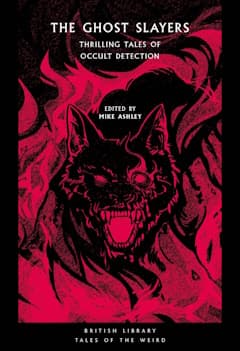
The Ghost Slayers edited by Mike Ashley
(British Library, 2022)
Reviewed by Graham Andrews
In February 1882, the Society for Psychical Research was founded in London. Mike Ashley explains that the SPR “was the first organization to take a methodical, scientific approach to researching reports of psychic or spiritualist events. Their work provoked much interest in Victorian Britain and led to an interest in ghost hunting” (Introduction). It also sparked off a renewed vogue for occult-detective stories, à la J. Sheridan Le Fanu’s Dr. Martin Hesselius (In a Glass Darkly, 1872), usually with Holmes-Watson partnership characters. “Holmes was not an occult detective [far from it, in fact!] but his cases were often unusual, and it was only a small step from Holmes to investigators of the paranormal” (ditto).
Ye Editor has arranged these “Classic Tales of Occult Detection” in chronological order of their first publication, so I will follow his eminently sensible lead. The first psychic detective off his mark is Flaxman Low, the creation of Kate and Hesketh Pearson, a mother-and-son writing team who initially used the pseudonym E. & H. Heron. In ‘The Story of the Moor Road’ (1898), Low describes himself as being “just one step above the specialist who makes a study of brain disease and insanity; he is at work on the disorders of the embodied spirit, while I deal with abnormal conditions of the free and detached spirit.”
Flaxman Low got off to a fast start, but he was soon overtaken by Dr. John Silence, the psychic-detective creation of Algernon Blackwood, about whom Ashley has written the definitive biography: Starlight Man (2001). ‘A Psychical Invasion’ (John Silence: Physician Extraordinary, 1908) is the longest story in the book and I would make so bold as to call it the best. It was almost certainly based upon a scholarly monograph exploring “how the mind can be opened to the paranormal through drugs—something Blackwood had experienced with almost fatal consequences when he was down and out in New York in the early 1890s” Silence was aided and chronicled by the no-nonsensical Dr. Hubbard.
William Hope Hodgson took over the preternatural baton from Blackwood, who had decided to give up that particular literary ghost. The result was Mr. (Thomas, it would seem) Carnacki, aka The Ghost-Finder. Carnacki would hold forth in his Cheyne Walk, Chelsea, residence to a group of friends, including no-forenamed Dodgson—aha!—the meticulous taker of minutes. He is well-represented here by ‘The Searcher of the End-House’ (The Idler, June 1910). All nine stories can be found in Carnacki the Ghost-Finder (Tom Stacey, 1972, and various paperback editions). Sad to say, however, Hodgson was killed near Ypres in April 1918, at just forty years of age.
Five of the six remaining short stories also hail from the early twentieth century: ‘The Fear’ (Claude and Alice Askew: (1914); ‘The Valley of the Veils of Death’ (Bertram Atkey: 1914); ‘The Death Hound’ (Dion Fortune: 1922); ‘The Case of the Fortunate Youth’ (1927); ‘Forgotten Harbour’ (Gordon Hillman: 1931). ‘Death Hound’ deserves a special mention. It echoes ‘Casting the Runes’, The Devil Rides Out, and The Hound of the Baskervilles. “Whatever it was that attacked [Mortimer] evidently leapt up, for he beat it away from his chest; then it circled round him, for he turned slowly so as to face it. Yard by yard he worked his way down the road and was swallowed up in the gathering dusk.”
The most recent story to have made the deft editorial cut is by Joseph Payne Brennan. Although Brennan began his career in 1948 with the Western pulp magazines, he gained more permanent recognition as one of the last writers to be “discovered” by Weird Tales. ‘Slime’ (WT, March 1953) has long been a classic of what Ashley has dubbed the “blob” school of horror fiction. But ‘In Death as in Life’ (Macabre, Winter 1963/64) features Lucius Leffing, his throwback-to-Victorian-times psychic detective, who psychically detects in darkest New Haven, Connecticut. And his Watsonian amanuensis is none other than author Brennan himself!
Review from BSFA Review 21 - Download your copy here.
